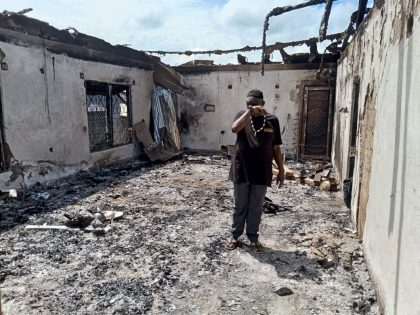Interrupting Paris Fashion Week
A group of black women, from Africa and its diaspora, decide to mess with Paris Fashion Week. Was it worth it? Did anyone care?

Image: Shamira Muhammad.
I wasn’t given very much information. Stumbling into the secretive meeting I’d been invited to, an all female brigade greeted me quickly as they pored over a hand drawn map of targets. Drawing on an apparently endless supply of cigarettes, peppered sometimes with wine, they debated logistics. It being Paris Fashion Week, they decided Gucci, Dior, Jimmy Choo and Versace would be some of the hardest to access.
Some puttered about worried, complaining about the well-being of a group of mostly black women possibly being approached by aggressive French police officers. Others were too busy calculating the number of fences to be jumped in front of certain locales.
But at 3:25 am, armed with black scarves, homemade glue, brooms and emergency safety routes, they were ready.
The women hurried towards what they saw as an act of guerrilla art-fare.
Volunteers hailing from Sierra Leone, Germany, Haiti, Morocco and Greece recently teamed up in Paris to participate in an extension of the French photographer JR’s ‘Inside Out Project’. Titled “Burning Borders and Building Bridges,” blown-up photographs of young men from the Folorunsho Collective in Freetown, Sierra Leone were plastered across the luxury retailers of the Parisian Avenue Montaigne.
Folorunsho is a “sharity,” a term coined by creator Mallence Bart-Williams. The boys who make up this collective range in age from 14 to 20, and most were originally members of a band of societal outcasts from an area called “Lion Base.”
Mallence teamed the young men up with local artists, who taught them batik dyeing and traditional embroidery. A sneaker company united with Folurunsho and a collection of sneakers were displayed in Paris’s premier department store, Collette. The proceedings from these are used by the boys in Freetown for what is for some their first housing, private tutors and nourishing food. With the help of friends, Mallence documented it all in a book, titled Lion Base, and a soon to be released documentary film.
Under the glare of the full moon, in that eerie hour that links night to morning, the women revealed the faces of “producers” Heaven Gate, Long Life, Base and others to the consumers of Paris.
The project’s press release revealed a mirror image:
We confront two individuals that each have 5000 to spend: the woman going to Avenue Montaigne to spend €5000 on a luxury accessory meets [a young man] that has SLL (Sierra Leone Leone) 5000 to spend on his next meal. When building a bridge two extremes are what give it balance and make it stand and sustain.
‘To be or to have?’ is the question we want to raise … from Freetown to Berlin to Paris … ‘Who is rich or poor?’ All is a matter of perspective.
But whose perspective was being demanded on Avenue Montaigne? Any attempt to provocatively interrupt Fashion Week activities with subjects that might make luxury consumers feel momentarily uncomfortable is often excellent fodder for media outlets. A dispute between two fashion giants makes front page. The scarred face of an African young man serves as an opportunity for voyeurism. Never mind the fact that this young man is intimately known to those revealing him.
People kind of like being voyeurs, and without an obvious context to who they’re peering at, would have and probably did denote the images of the boys to the standard “poor African” archetype. Even with a thorough press release, attempts to complicate those images were most by most people. If the action was covered on some blogs, it was not reported at all in mainstream French media.



















